To the general public, chickens might seem like they’re all the same and just bred for producing meat and eggs. However, there are numerous breeds of chickens around the world, each with their own unique traits. Unfortunately, many of these breeds are endangered because there is not widespread interest in raising them. So if you’re thinking of getting some chickens, look into the ones on this list and help keep these breeds alive!
While there are too many rare breeds out there to name, the ones on this list are some of the rarest in the world. They were chosen because data about their estimated population was widely available, so there might be some even rarer chicken breeds that were passed over. Additionally, excluding the Top 3 rarest chicken breeds on this list, the others did not have specific estimated population numbers and were deemed critical by The Livestock Conservancy. This means that there are fewer than 500 breeding individuals in the U.S. and worldwide population is likely fewer than 1,000. For this reason, the rest of the list was arranged in alphabetical order.
As of October 2020, the information on this list is as accurate as possible and will be updated as needed.
- Sultan
- Modern Game
- La Flèche
- Holland
- Derbyshire Redcap
- Crèvecoeur
- Campine
- Onagadori
- Old English Pheasant Fowl
- Burmese
Country of Origin: Turkey
Conservation Status: Critical by The Livestock Conservancy and Priority Breed by Rare Breeds Survival Trust
Use: Ornamental

photo source: Wikimedia Commons
The Sultan (known as Serai Took in Turkish) hails from Turkey and is a rare ornamental breed. It has been deemed critical by The Livestock Conservancy and is a priority breed under the Rare Breeds Survival Trust. As its name suggests, the Sultan was originally developed as an ornamental breed for the Sultan of Constantinople (now Istanbul). The breed was brought to the U.K. in 1854 by Miss Elizabeth Watts of Hampstead, London. Today, all Sultans in the U.K. are descended from this original flock.
Did You Know?
The Sultan has the more distinguishing features than any other breed, which include V-shaped comb, crest, beard, muffs, large nostrils, wings carried low, vulture hocks, feathered shanks and toes, and is one of the few breeds with five toes on each foot.
Country of Origin: England
Conservation Status: Critical by The Livestock Conservancy and Priority Breed by Rare Breeds Survival Trust
Use: Ornamental

photo source: mypetchicken.com
The Modern Game is another unique-looking chicken that it bred only for exhibition purposes. The breed has exceptionally long and thin legs and a slender body. Modern Game originated in England and was developed to epitomize the visual appeal of the gamecock or fighting cock after cockfighting became illegal in 1849. The birds are not good egg layers and do not do well in really cold weather because of their short feathers.
Did You Know?
The Modern Game comes in a standard and bantam size. While large Modern Game are incredibly rare, the bantams are fairly popular.
Country of Origin: France
Conservation Status: Critical by The Livestock Conservancy
Use: Eggs and Meat

photo source: morningchores.com
Like the Crèvecoeur, La Flèche is another rare French chicken breed whose numbers were devastated by the Second World War and never recovered. Some La Flèche were imported to the U.S., England, and Germany in the late 19th century and the breed has survived in small numbers in these countries.
Of all the French chicken breeds, La Flèche is said to have the best quality meat. La Flèche meat has thin white skin with tender, juicy, delicate, short-grained flesh. The breed also fattens well, with the fat distributed across the breasts, legs, thighs, and even the back.
Did You Know?
La Flèche roughly translates to “the arrow” and is in reference to the breed’s unusual v-shaped or arrow-like comb.
Country of Origin: United States of America
Conservation Status: Critical by The Livestock Conservancy
Use: Eggs and Meat

photo source: spoiltpups.com
The Holland is the rarest American-born chicken breed and has never enjoyed widespread popularity. The breed was developed at the Rutgers Breeding Farms in New Jersey, following interest in a dual-purpose bird that would produce white eggs. Chickens imported from Holland were crossed with White Leghorns, Rhode Island Reds, New Hampshires, and Lamonas, which produced White Hollands.
Did You Know?
The more popular variant of the Holland, the Barred Holland was created by mixing White Leghorns, Barred Plymouth Rocks, Australorps, and Brown Leghorns – the Barred Holland looks very similar to the Barred Plymouth Rock breed.
Country of Origin: England
Conservation Status: Critical by The Livestock Conservancy
Use: Eggs and Meat

photo source: poultryclub.org
Although the Derbyshire Redcap is a hardy breed that isn’t prone to common poultry illnesses, the breed was never kept commercially, which has led to its rarity. In its native home of England, the breed has mostly been kept by small farms around Derbyshire and by 1960 the breed became very rare because the Derbyshire Redcap club had shut down. The club was revived in the late 1970s, but the Derbyshire Redcap is still hard to come by.
Did You Know?
Unlike most modern chicken breeds, the Derbyshire Redcap is pretty pure and has very little crossbreeding in its history.
Country of Origin: France
Conservation Status: Critical by The Livestock Conservancy
Use: Eggs and Meat and Ornamental

photo source: Wikimedia Commons
The Crèvecoeur is one of the oldest French chickens. Its origins are mostly a mystery, but the Crèvecoeur was developed in Normandy and probably existed for several centuries. The Crèvecoeur has high quality meat and eggs, which is was used for in the past. These days, the Crèvecoeur is mostly ornamental and featured in poultry exhibitions because of its fluffy crest.
At one point, the Crèvecoeur was quite popular in France, but its population was devastated by both World Wars. Following World War II, people believed that the Crèvecoeur had been nearly wiped out. Recovery began in the late 1970s, but the Crèvecoeur’s numbers were never that robust and have hovered around 1,000 or so for the past few decades.
Did You Know?
Unlike most modern chicken breeds, the Derbyshire Redcap is pretty pure and has very little crossbreeding in its history.
Country of Origin: Belgium
Conservation Status: Critical by The Livestock Conservancy and Priority Breed by Rare Breeds Survival Trust
Use: Eggs and Ornamental

photo source: Wikimedia Commons
The Campine originally comes from Kempen (or Campine) region of Belgium and has been deemed critically endangered by The Livestock Conservancy in the U.S. and a priority breed by the U.K.’s Rare Breeds Survival Trust. Unfortunately, this means that the Campine’s estimated global population is fewer than 1,000 individuals. Campines were first brought to U.K. and the U.S. in the late 19th century. While Campines were briefly fairly popular with English breeders, they never took off in the U.S. because they weren’t that hardy. Today, Campines are still one of the rarest domestic chicken breeds.
Did You Know?
Campines come in two color varieties: the Silver and Golden. When a Silver Campine female is bred with a Golden Campine male, chicks can be sexed at a day old because female chicks have a reddish blush and the males have gray on the top of their heads.
Country of Origin: Japan
Conservation Status: Endangered by FAO
Use: Ornamental

photo source: Wikimedia Commons
While long-tailed chickens are prized around the world for their beauty, none are as impressive or majestic as the Onagadori from Japan. Like a few of the other chicken breeds on this list, the Onagadori is pretty ancient and has been bred since at least the 17th century. In 1952, the Onagadori was designated a Japanese National Natural Treasure and the chickens and their eggs are no longer allowed to be exported out of the country.
There are only about a dozen breeders with about 250 or so Onagadori. Any Onagadori chickens found outside of Japan are descended from exports prior to the National Natural Treasure designation. While pure Onagardori are rare outside of Japan, the breed is one of the ancestors of the German Phoenix chickens, which are often confused for Onagadori.
Did You Know?
Onagadori tails can range in length from 4.9 feet (1.5 meter) to 27 feet (88.58 meters) because they rarely or never molt and grow rapidly.
Country of Origin: England
Conservation Status: Priority Breed by the Rare Breeds Survival Trust
Use: Eggs and Meat and Ornamental
 photo source: Wikimedia Commons
photo source: Wikimedia Commons
The Old English Pheasant Fowl is another rare chicken that is primarily kept in the United Kingdom. This native English chicken is an old breed and has been around for centuries. Despite being great egg-layers and the males having large enough breasts for food, the Old English Pheasant Fowl was never kept by large scale commercial producers. This is probably because the Old English Pheasant Fowl is very active and needs extensive free-range conditions. However, the Old English Pheasant Fowl is a hardy breed with a long lifespan, making it perfect for small breeders.
Did You Know?
The Old English Pheasant Fowl didn’t receive its current name until 1914; before this, it was known as the Yorkshire Pheasant, Golden Pheasant, and also the Old-fashioned Pheasant.
Country of Origin: Myanmar (Burma)
Conservation Status: Priority Breed by the Rare Breeds Survival Trust
Use: Ornamental
 photo source: rarepoultrysociety.com
photo source: rarepoultrysociety.com
The Burmese chicken or Burmese Bantam is the rarest chicken breed in the world with a very scarce population and only a handful of breeders around the world. According to the last time that the Burmese population in the United Kingdom was surveyed by the Food and Agriculture Organization of the United Nations, there were only about 102 chickens, with their numbers decreasing. There hasn’t been any recent updates on the Burmese population, but several sources cite the chicken as exceedingly rare.
As its name suggests, the Burmese was originally from Myanmar (formerly called Burma in English) and it first made its way to the U.K. in the late 19th century. Although the Burmese is a unique-looking chicken – they have short legs, very feathery feet and crests, and sometimes have beards – it never caught on in popularity, which has led to its scarcity.

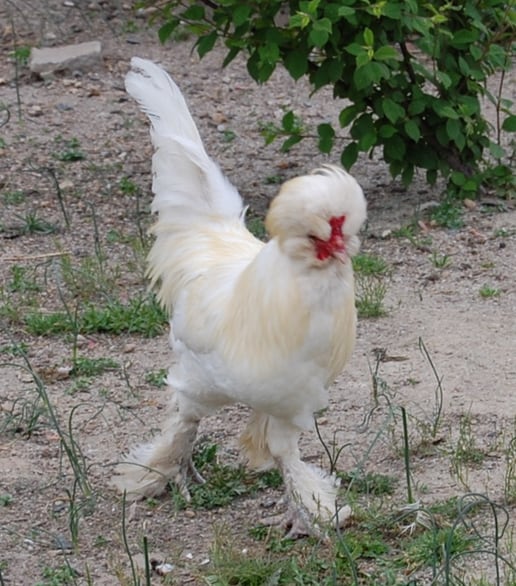
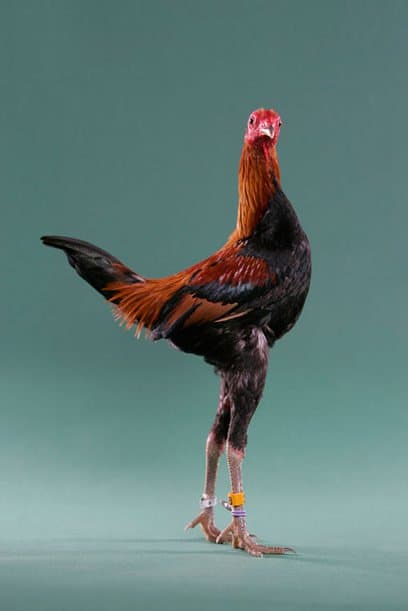
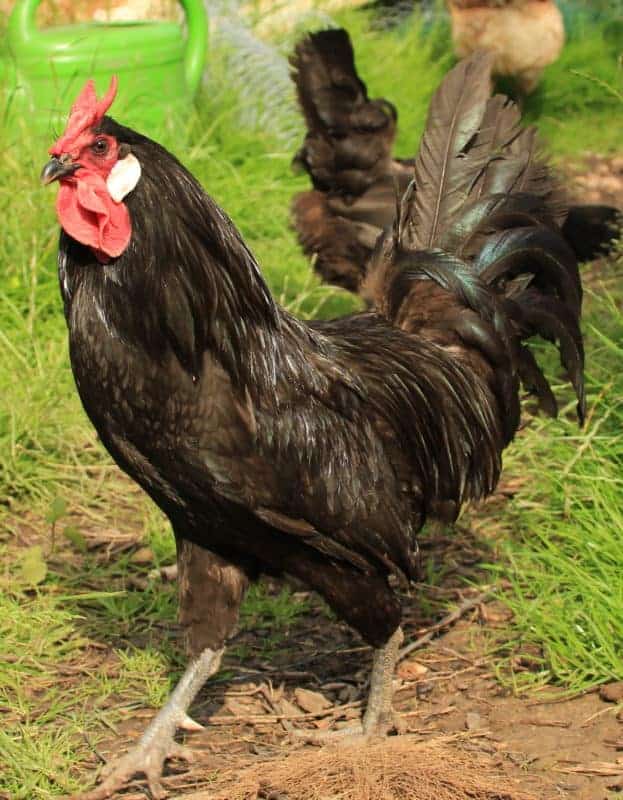
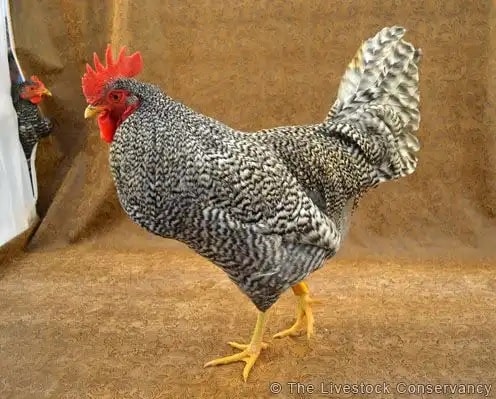
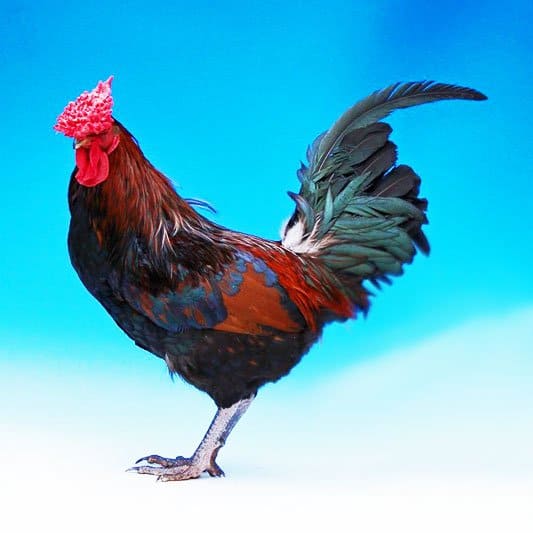
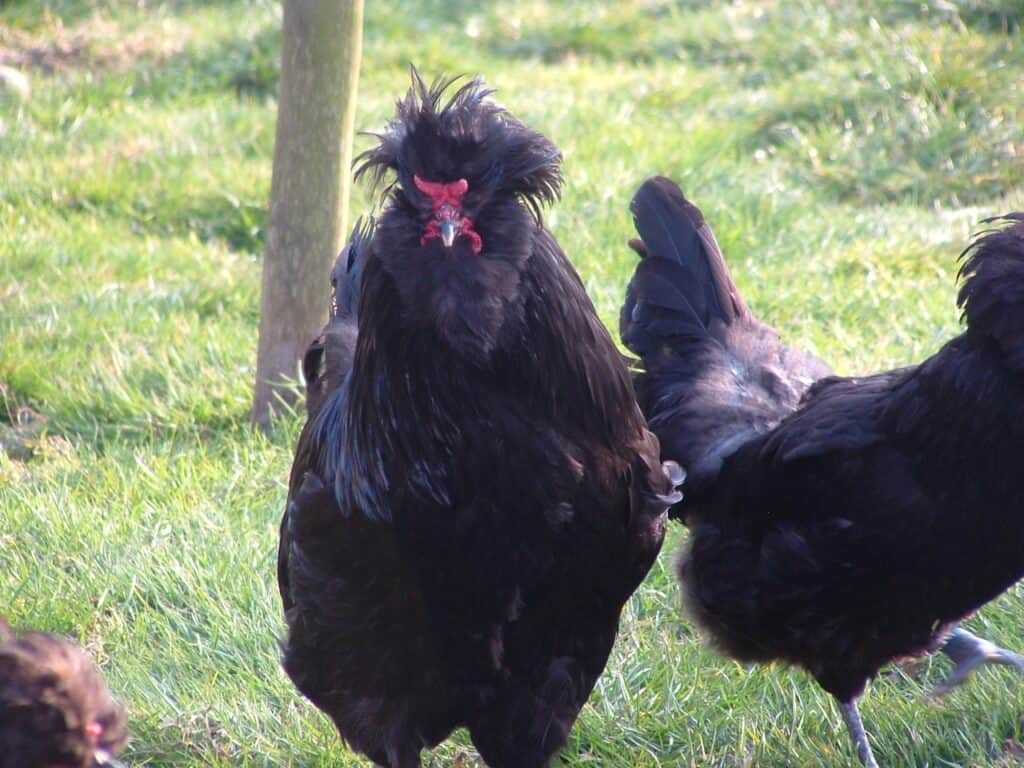

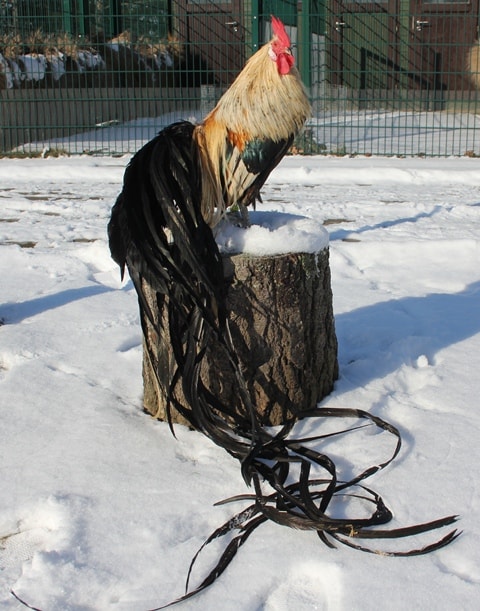
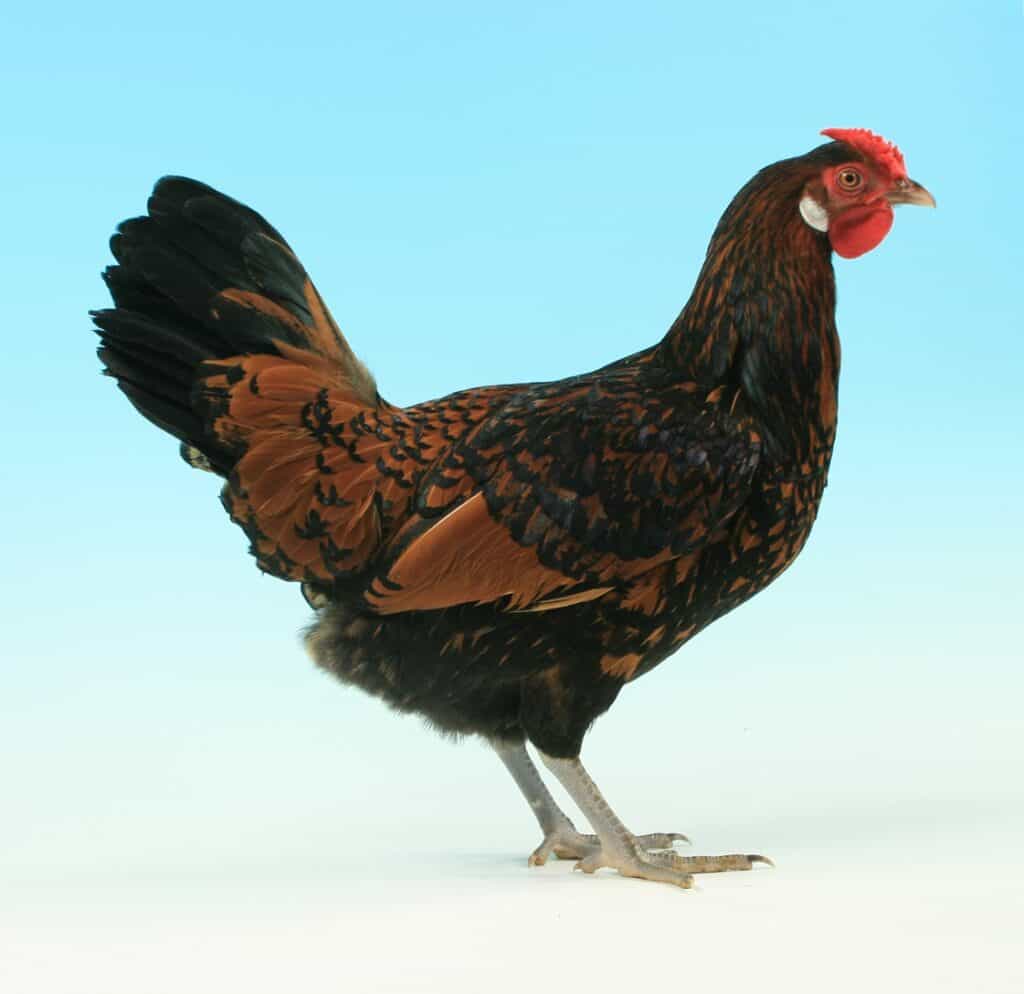 photo source: Wikimedia Commons
photo source: Wikimedia Commons